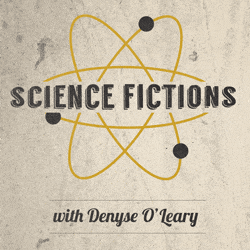 Evolution
Evolution
 Life Sciences
Life Sciences
Welcome to “RNA World,” the Five-Star Hotel of Origin-of-Life Theories

In 1953, Stanley Miller and Harold Urey famously electrified a glass chamber of chemicals, producing compounds associated with life. The news, coming in the same year as Watson and Crick identified the double helix, began to shape the popular imagination: Scientists will soon discover how a random flash of lightning somehow sparked life.

After that, just about any naturalist hypothesis got the mike. As a Science article noted in January, “Rather than knowing too little, we increasingly know about too many possible mechanisms.” Yet none that explain. Which may not matter. “Primordial soup,” the iconic chemicals that somehow became life, has thrived as a concept for eighty years, though no one knows the recipe. Popular faith in a fully natural origin of life thrives just as well on new theory as on new evidence.
When a cell divides, its DNA’s operational instructions are copied by RNA (ribonucleic acid), which directs the proteins that build cell machinery. The current leading origin of life hypothesis, RNA world (or RNA first) offers a limited and researchable claim, first proposed in 1967 by Carl Woese, Leslie Orgel, and Francis Crick: that RNA preceded and stood in for DNA in ancient life. Because this route slightly reduces the awesome complexity, it was not only too good to be false, it was hailed by key researchers as “the molecular biologist’s dream.” By 1986, biochemist (and Nobelist) Walter Gilbert envisioned a whole RNA “world” and Leslie Orgel was almost certain it had existed.
Not everyone was or is “almost certain.” Gustavo Caetano-Anolles is convinced of the opposite because “That world of nucleic acids could not have existed if not tethered to proteins.” A. G. Cairns-Smith, admittedly a champion of a rival “clay origin” theory, labeled it “absurd to imagine,” complaining that there are “14 major chemical/molecular hurdles” against more primitive nucleotides like RNA. New York University chemist Robert Shapiro (1935-2011) compared the theory’s likelihood to “a gorilla composing, in English, a coherent recipe for the preparation of chili con carne” and pleaded for greater realism.
Yes, RNA theorists admit, there are difficulties. The very same people who called RNA world “the molecular biologist’s dream” also called it “the prebiotic chemist’s nightmare.” Suggested fixes abound. A Texas Tech paleontologist proposes that craters full of hot water enabled RNA and proteins to emerge simultaneously. No, says another researcher, life may have got started in a cold environment, in which one study showed RNA replicated more successfully (though with considerable assistance).
Could an “RNA reactor” have preceded life, as a computer simulation has suggested? Could a “midwife molecule” have helped RNA strands to organize themselves? Could TNA, a simpler nucleic acid that uses threose instead of ribose (as in RNA), have preceded both RNA and DNA? No trace of TNA is found in known life forms though threose does exist in nature. The RNA reactor and the midwife molecule, by contrast, may only exist in the minds of theorists.
Science journalists are undeterred by these difficulties. New Scientist tells us, “RNA world is growing ever more convincing. Only a few dissenters remain.” Indeed, good press is a considerable point in the theory’s favor. We hear about the problems of RNA world only when a different thesis, irrespective of likelihood, is on offer. For example, Charles Carter dismisses RNA world because “It would take forever.” Also, the synthetic ribozymes researchers create to catalyze needed reactions “bear little resemblance to anything anyone has ever isolated from a living system.” Instead, he proposes “molecular fossils” (Urzymes), evolved from peptides, which “co-evolved with RNA to give rise to more complex life forms” — a “Peptide-RNA World” scenario. It offers variety, anyway.
Shapiro assessed RNA world like this:
I’m always running out of metaphors to try and explain what the difficulty is. But suppose you took Scrabble sets, or any word game sets, blocks with letters, containing every language on Earth, and you heap them together and you then took a scoop and you scooped into that heap, and you flung it out on the lawn there, and the letters fell into a line which contained the words “To be or not to be, that is the question,” that is roughly the odds of an RNA molecule, given no feedback — and there would be no feedback, because it wouldn’t be functional until it attained a certain length and could copy itself — appearing on the Earth.
The recent Science paper quoted above, telling us that we know too many, not too few paths for the origin of life, also suggests how an RNA origin “can be imagined,” as if the ability to imagine an event like the Scrabble message contributes to its likelihood.
So as mathematician David Berlinski notes, the basic problem is that RNA world proposals are “dominated by references to a number of unspecified but mysteriously potent forces and obscure conditional circumstances …” The technical term for that is magic. Nevertheless, RNA world is the best fully natural origin of life scenario today.
Earlier, we observed that, from an information realist perspective, life forms differ from inanimate matter by the astonishing leaps in information-content they embody. One result, often overlooked in the bickering over the origin of the genome, is that most of this information is not in or from the genome:
All the components of the cell, including all the RNA and protein molecules, are continuously communicating with each other. It is recognized that there are hundreds of thousands of different types of interactions within the cell’s “interactome,” and most of these interactions in one way or another involve communication. In this sense, the amazing communication network within a cell can very reasonably be compared to the Internet.
Life, it seems, is mostly information, not matter. The origin of life is the origin of information. And intelligences are the only entities we know of that definitely create information.
Or are they? Can information self-organize by an as-yet-unknown process?
Editor’s note: Here are links to the whole “Science Fictions Origin of Life” series.
Image: Precambrian stromatolites/Wikipedia.
